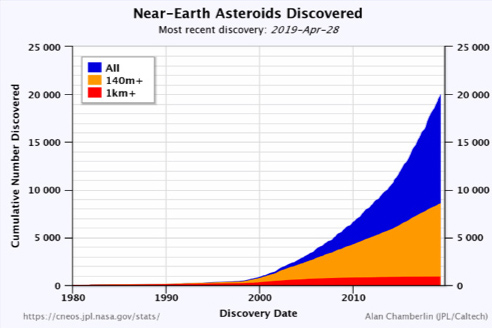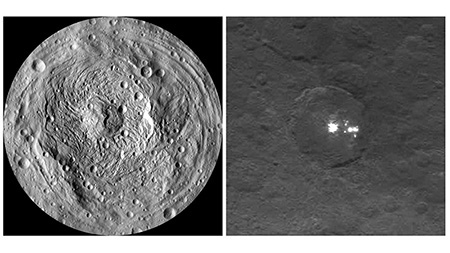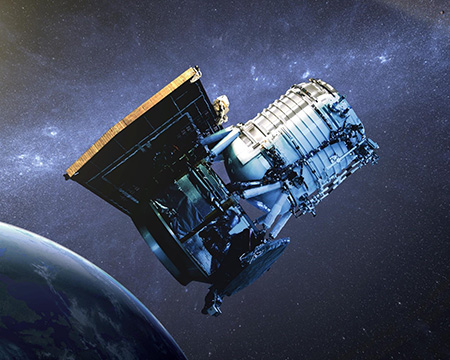The small bodies of the Solar System (asteroids, comets, Kuiper belt objects, icy moons, rings, and dust) represent archives of the state of the proto-solar disk at various times and places during the history of our Solar System’s formation. Researchers at JPL study the physical properties of these objects using ground-based and space-based telescopes, in-situ spacecraft investigations, and numerical simulations of their formation and evolution, as well as providing mission leadership and support. By combining visible light photometry and spectra, infrared radiometry, radar observations, surface composition maps, and dynamical evolution, a more complete picture of the compositions of these bodies, their histories, and their futures can be constructed.
In addition, a critical aspect of small-body research involves maintaining and exporting the high-precision positions for each of the eight planets in the Solar System, 181 natural satellites, and hundreds of thousands of comets, asteroids, and KBOs through the Solar System Dynamics (SSD) group, which currently amounts to about 800,000 objects. SSD group’s HORIZONS ephemeris service has provided more than 190 million predictions from over one million different computers for Solar System object positions to an international community of scientists.
SSD group also runs the Center for Near-Earth Object Studies (CNEOS), which is tasked with computing high-precision orbits for potentially hazardous asteroids and comets and statistical assessments of impact probability in support of NASA’s Planetary Defense Coordination Office. CNEOS maintains two key tools: the Scout system that analyses newly discovered objects in real-time for any near-future hazard they may pose to Earth, and the Sentry system which performs long-term analyses of any potential impact over the next century or more.
Current Challenges
Small body research at the Jet Propulsion Laboratory is geared towards addressing the following challenges:
What are the hazards that asteroids and comets pose to the Earth?

Near-Earth Objects (NEOs) are asteroid and comets that have been nudged from their original, stable orbits and have been send on paths that come close to the Earth’s orbit. They are scientifically interesting as nearby targets for observation and exploration, but also can pose a threat to life on Earth if they are on an impact trajectory. The bolide that exploded over Chelyabinsk, Russia in 2013 served as a reminder of the destructive potential of even these smaller NEOs. Searching for new objects and monitoring known ones is a critical component to understanding their risk.
JPL’s Solar System Dynamics (SSD) group is responsible for maintaining and improving the orbits of all small bodies in our Solar System. The Center for Near-Earth Object Studies (CNEOS) focuses on the NEOs that closely approach the Earth. The SSD group continuously monitors the motions of these objects by improving knowledge of their orbits. CNEOS performs statistical studies to identify future Earth close approaches and, for objects of particular interest, computes Earth-impact probabilities. They provide impact probabilities to observers around the world, highlighting which objects require new data to rule out future impact possibilities.

Detecting and tracking new NEOs is another key aspect of understanding the hazard they pose. The Wide-field Infrared Survey Explorer (WISE) was a NASA telescope in a sun-synchronous orbit that ran out of its coolant, as planned, in October 2010. Prior to being put into hibernation in 2011, WISE conducted a program of searching for and characterizing NEOs. In August 2013, it was refurbished as a new mission, dubbed NEOWISE, with a dedicated goal of finding and studying NEOs. As of the beginning of 2019, WISE and NEOWISE have discovered 279 NEOs, 51 of which are Potentially Hazardous Objects that approach to within 0.05 AUs of Earth and are sufficiently large (~100 m in diameter) to cause massive devastation on the Earth should they impact. Twenty-eight comets were also discovered. One of the major scientific results of the mission was that low-albedo carbonaceous asteroids are far more common among the NEO population than previously thought. Follow-up observations from facilities like the Goldstone radio telescopes and the Table Mountain Observatory provide important information about the positions and properties of these objects.
What are the reservoirs of water and organics in the Solar system, and what was their contribution to the early Earth?

Water and organics are the building blocks of life on Earth, but may not have originally been abundant when the Earth formed. Missions like Dawn and Rosetta help us better understand the small Solar system bodies like the ones that brought these materials to the Earth after its formation.
Dawn is the first mission to study Main Belt asteroids in great detail. The mission’s investigations have centered around two of the three protoplanets among the asteroids -- the rocky (4) Vesta and the carbonaceous, aqueously altered (1) Ceres. Launched in 2007, Dawn entered orbit around (4) Vesta in 2011 for a 14-month mission. The main goals of the investigation at Vesta were to characterize the geology and composition of the asteroid, and to understand its connections to the largest group of terrestrial meteorites, the basaltic achondrites. To this end, Dawn characterized a large impact basin at the South Pole of Vesta, the likely source of the meteorites. After a successful tour, Dawn left Vesta for a cruise trajectory and entered orbit around (1) Ceres in late 2012. Dawn discovered evaporate deposits in the floor of a large crater, suggesting that liquid may lie underneath its surface. Dawn will remain in orbit around Ceres.
Rosetta is a European Space Agency mission to closely study and characterize Comet 67P/Churyumov-Gerassimenko through a perihelion passage. NASA contributed three instruments to the mission: the Microwave Instrument for the Rosetta Orbiter (MIRO), built and managed at JPL, the Alice ultraviolet spectrometer, and the Ion Electron Spectrometer (IES). JPL manages the NASA contributions to the Rosetta mission. In addition, numerous NASA-funded US Co-Investigators contributed to the European instruments on Rosetta.

Rosetta was launched in 2004, and rendezvoused with the comet in August 2014 for a detailed study of its nucleus, dust and ion coma, and its interaction with the solar wind. Its Philae probe was jettisoned from the spacecraft on November 12, 2014 in order to land on the surface of the comet. The lander’s instruments returned data for two days. Among the unexpected discoveries at the comet were molecular oxygen, a patchy distribution of water ice at its surface, a far more complex surface with cliffs, outgassing-pits, boulders, and a layered structure. Comet 67P is a nearly binary object, likely formed from two planetesimals.
How did the Solar system evolve from formation into its current configuration?
The great diversity of material in the main asteroid belt and the near-Earth object populations leads us to conclude that the Solar system underwent significant mixing as the asteroid, comets, and planets were forming. Observations from Dawn indicate that Ceres may have formed much farther from the Sun than its present day location, while comet 67P/Churyumov-Gerassimenko contains ices from the edge of the Solar system. How these bodies were moved, and when, sets important constraints on the motions of the planets as they were forming, the early evolution of the Sun, and even if there might be objects lurking undiscovered at the edge of the Solar system.